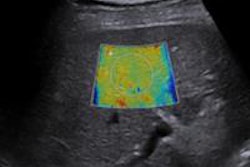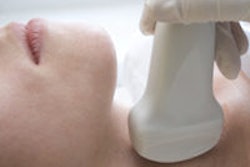
German researchers have found that shear-wave elastography (SWE) can help clinicians track the long-term effects of total knee arthroplasty, according to a study published online on 14 September in Academic Radiology.
The findings offer clinicians another option for patient follow-up besides MRI, which has often been used in conjunction with B-mode ultrasound and power Doppler ultrasound, wrote a team led by Dr. Valentin Quack of University Hosptial RWTH Aachen in Germany.
"SWE allows real-time quantification of tissue stiffness, and, by this, the assessment of the mechanical properties of a tendon and its changes during acute disease and tendon healing," Quack and colleagues wrote.
Tracking the effects of total knee arthroplasty has typically been performed with B-mode ultrasound, power Doppler ultrasound, and MRI. But in the past 10 years, shear-wave elastography has become an option for tendon imaging -- offering an alternative to the more expensive and perhaps less effective MRI exam, according to the researchers.
"Ultrasound and [MRI] have a limited correlation with clinical symptoms and do not provide any information about the mechanical properties of the tendons," the group wrote. "Shear-wave elastography is a modern ultrasound technique that allows the real-time quantification of tissue stiffness and, by this, the evaluation of the mechanical properties of a tendon."
Currently, there is no ultrasound-based research that evaluates tendon changes, anatomical and mechanical properties, and tendon healing of the patellar and quadriceps tendon following total knee arthroplasty, according to the group. So Quack and colleagues conducted a study that used SWE to analyze morphologic, vascular, and mechanical properties of patellar and quadriceps tendons in patients following arthroplasty, with a decline in tendon stiffness indicated success of the surgery.
The study included 63 postoperative patients with 76 total knee arthroplasties and 50 nonoperative knees for comparison. Every study participant underwent B-mode ultrasound, power Doppler ultrasound, and shear-wave elastography of the left and right patellar and quadriceps tendons, for a total of 152 postoperative tendons and 100 nonoperative tendons.
The researchers found that SWE showed statistically significant differences in tendon stiffness in the knees of patients who underwent arthroplasty and those who did not, with lower kilopascal (kPa) values indicating less tendon stiffness:
| Tissue stiffness of tendons on SWE | |||
| Operated tendons | Nonoperated tendons | ||
| Quadriceps tendons | 36.43 kPa | 52.65 kPa | |
| Patellar tendons | 45.69 kPa | 60.08 kPa | |
"We found a significant reduction of tendon stiffness assessed by SWE after total knee arthroplasty, compared to nonoperated knees," the group wrote.
SWE offers another way to track tendon healing after total knee arthroplasty, the authors concluded.
"SWE was reliably able to measure and display ... tendon changes, which, in line with previous studies, might allow SWE to evaluate and monitor tendon healing," they wrote.



















